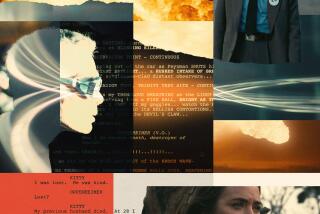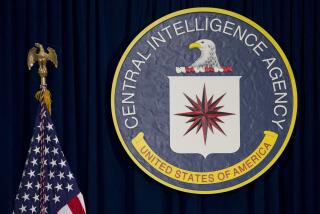Witness Tells of Iran-Contra Cover-Up : Trial: Weeping Fiers recounts praise from Clair George, who he testifies ordered him to withhold details from Congress of downing of supply plane.
WASHINGTON — A former CIA official wept Wednesday as he testified that Clair E. George, once the agency’s third-highest official, successfully recommended him for two agency awards during the period in which, he said, the two men tried to cover up their knowledge of the Iran-Contra affair.
The dramatic testimony by Alan D. Fiers demonstrated the high emotions that gripped some officials of the CIA as the Iran-Contra secrets began to unfold.
The rare display by Fiers, who headed the CIA’s Central American task force, came as he provided crucial testimony against his former superior. He told jurors that George ordered him not to provide crucial details to Senate and House committees about the Oct. 5, 1986, downing of a Contras resupply plane.
George, the former CIA deputy director for operations, is on trial in federal court here on nine counts of perjury, making false statements and obstruction for his testimony to Senate and House committees and a federal grand jury investigating the Iran-Contra affair. Fiers, his former subordinate, pleaded guilty last year to two misdemeanor counts of withholding information from Congress and became a government witness in the investigation.
As Fiers, a former Ohio State University football player, neared the end of his second day of testimony, he lost control of his emotions. It happened when chief prosecutor Craig A. Gillen asked whether George had recommended him for high agency awards in 1985 and 1986 for foreign intelligence work in Nicaragua and a covert action effort he managed.
His voice cracking, Fiers removed his glasses to wipe away tears. He acknowledged receiving $30,000 in stipends for the awards, in which George praised his performance as “an extraordinary tour de force.” Later, leaving the courtroom, George stopped short in his tracks to avoid running into Fiers in the courthouse corridor.
Fiers’ testimony seemed to provide substantial support for the prosecution’s case. He spoke about preparing an opening statement that George could give when both men appeared before a closed session of the Senate Foreign Relations Committee. The panel was looking into the shooting down of the resupply plane.
In an Oct. 7, 1986, meeting in George’s CIA office to discuss the testimony scheduled for three days later, George ordered Fiers to delete a section that attempted to explain the “background” of aid being flown to the Contras by “private benefactors,” Fiers testified.
“Alan, I don’t want to say that,” Fiers testified that George said, in instructing that the section be dropped. When Fiers persisted, arguing that otherwise the private resupply flights would seem to have popped out of nowhere, George said that such testimony “puts the spotlight on the White House or the Administration or Oliver North,” Fiers testified, referring to former White House aide Oliver L. North.
“I’m not sure which one of the three he used,” Fiers testified, adding that George said: “I don’t want to be the first person to do that.”
Fiers said George also overruled him in replying to a question they were certain to be asked about the identity of Max Gomez. The sole survivor of the downed plane, Eugene Hasenfus, had named Gomez as one of those running Contra resupply flights out of Ilopango airfield in El Salvador.
Fiers testified that he knew and had discussed with George that Gomez was an alias for Felix Rodriguez, a former CIA operative with ties to the office of then-Vice President George Bush.
George, however, insisted that they testify they did not know for certain that Gomez was actually Rodriguez. “We’re not going to say we know. We’re going to say we’re still checking on that,” Fiers quoted George as stating.
Fiers said he told George: “But, Clair, I know that Max Gomez is Felix Rodriguez, for God’s sake.”
“He said, ‘No, we’re going to say we’re still checking,’ ” Fiers added.
George is charged with two counts of false statements for that testimony.
In acknowledging that he gave the same story to House and Senate committees, Fiers told jurors: “That was the script for the day, and I followed the script for the day.”
Fiers described an Oct. 14, 1986, meeting with George and then-CIA Director William J. Casey, in which he told the two officials that “we’re going to continue to have a problem until someone stands up and takes responsibility” for the Contra resupply flights.
When Casey asked who he would suggest, Fiers said he proposed retired Air Force Maj. Gen. Richard V. Secord, but George disapproved the idea, saying that Secord had “other problems.” Fiers said he did not know then that Secord was involved in secret U.S. arms sales to Iran.
About the only levity in the court session came when jurors were watching the Nov. 25, 1986, press conference in which then-President Ronald Reagan and Atty. Gen. Edwin Meese III disclosed that funds from the secret sale of arms to Iran had been diverted to support the Contras.
Meese was asked at the press conference why Reagan didn’t know that the diversion was occurring and answered: “Because no one told him.” Jurors broke their normally grim expressions with broad grins.
More to Read
Get the L.A. Times Politics newsletter
Deeply reported insights into legislation, politics and policy from Sacramento, Washington and beyond. In your inbox three times per week.
You may occasionally receive promotional content from the Los Angeles Times.










